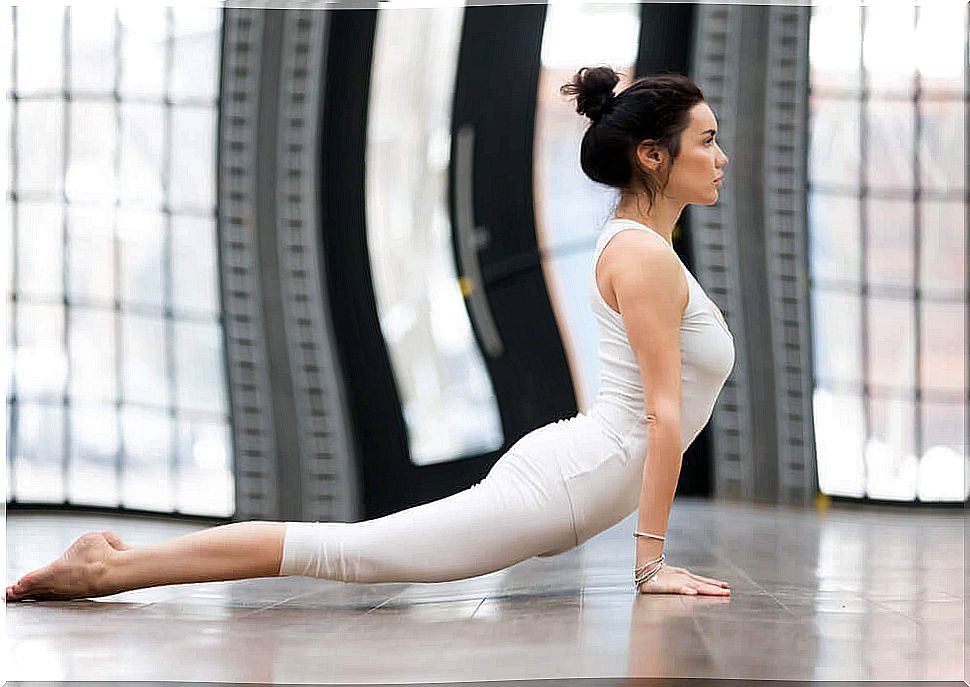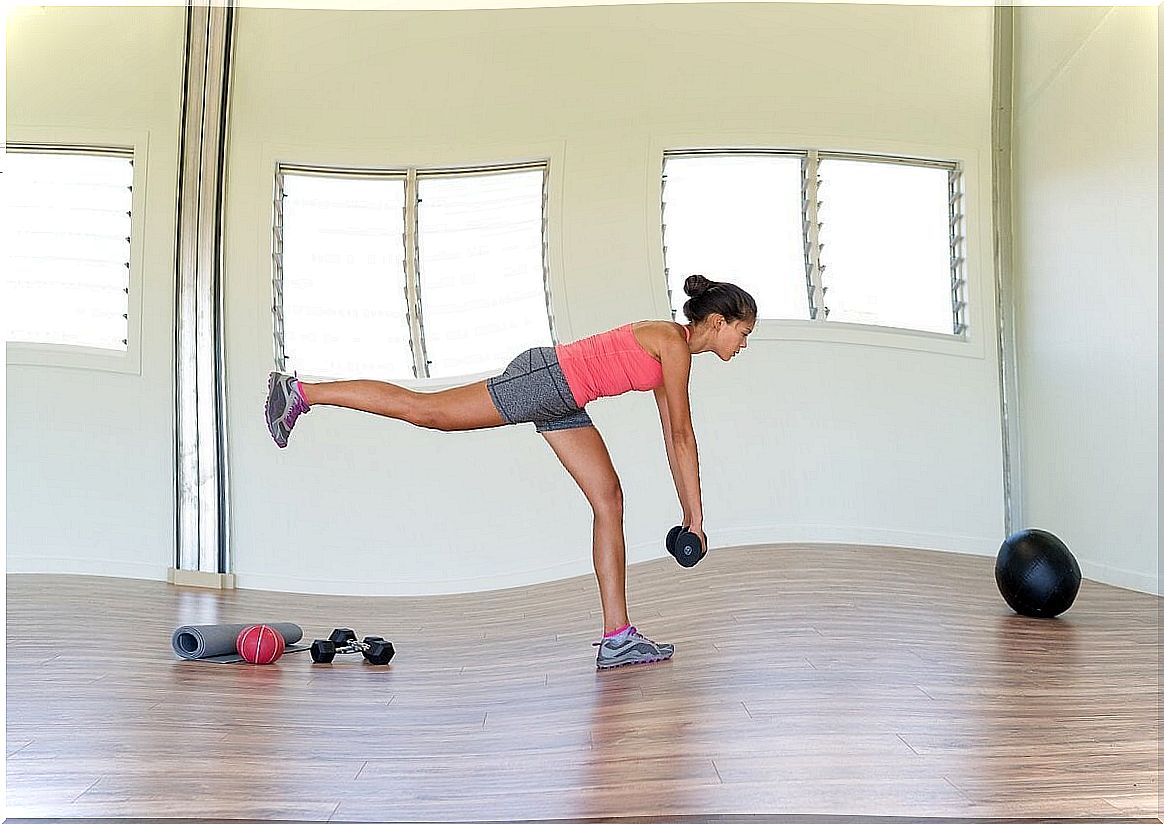Back Routine: 8 Basic Exercises
Exercises to strengthen the back help reduce the risk of injury and illness. In turn, they increase balance and flexibility. Do you dare to practice them? Discover some options.

Exercises for a back routine cannot be missed when doing a workout to strengthen muscles, bones and tissues. These not only help to stabilize the body, but also promote posture and help prevent ailments.
Now, there are basic exercises that help to take care of the health of the vertebrae and muscles just by practicing them regularly. Do you dare to do them? In the following space we share them in detail.
Why is it important to exercise your back?
An exercise routine for the back has both cosmetic and health benefits. In particular, it contributes to the following:
- Maintain the natural curvature of the spine.
- Reduce body aches and back injuries.
- Reduce muscle imbalances, that is, the weakening of the muscles and the loss of their ability to stretch, as mentioned in the International Journal of Medicine and Sciences of Physical Activity and Sport.
- Maintain stability to lift objects and carry out movements.
Back exercise routine
The practice of a routine of exercises for the back is key to avoid ailments in this area of the body. A scientific article published in Ochsner Journa l determined that strengthening the lumbar and cervical extensors reduces pain and improves quality of life in people who often have low back discomfort. Start now!
1. Cobra pose
The cobra pose is known in yoga as ‘Bhujangasana’. It consists of a slight backward bending that reduces tension on the back muscles, while stretching and strengthening them.
How do you do it?
- To start, lie face down on a mat. Rest your palms under your shoulders. Your elbows should be bent, avoid leaning or going out to the sides. They should be kept close to each side of the chest.
- Next, press down on the ground with your hands and lift your head and chest. If you can, fully extend your arms.
- Gently drop your head back to deepen the stretch.
- Hold this position for 10 seconds.
- Return to the starting position and complete 10 reps.

2. Dumbbell row
This rowing exercise is simple and ideal for working traps, lats, and rhomboids. Once you get the hang of it, you can try some of its variations. The ideal is to use a light weight dumbbell to stimulate the contraction of the muscles, strengthen them and promote the increase of muscle mass.
How do you do it?
- On a mat, get into a four-point position, that is, hands under your shoulders and knees under your hips.
- Hold the dumbbell in one hand.
- Contract your abdomen and make sure to keep your back straight.
- The hand holding the dumbbell will begin the exercise as it will bring the bent elbow back to bring the dumbbell closer to your chest.
- Extend your arm and return it to the ground.
- Repeat the exercise 15 more times with the same arm.
- Follow these instructions with the opposite arm.
3. Pull down with resistance band
In the gym you can find machines to perform this exercise with weights. However, you can also do it at home with an elastic resistance band. Through this you can work your lats, biceps and forearms.
How do you do it?
- First, place the rubber band on a tall support. The ends of the band should fall to each side.
- Standing with your legs hip-width apart and your back straight, hold each end with your hands.
- Pull the elastic band, bringing it towards your chest. The elbows should be bent on each side of the body towards the ground, approaching the waist.
- Keeping your back straight at all times, extend your arms up again and repeat the exercise.
- Perform three sets of 10 reps.
4. Deadlift on one leg
To work your erector spinae, lower back, and hamstring muscles, the deadlift is a good exercise. In addition, it helps you improve balance. To make it easier, it is advisable to hold a dumbbell in each hand.
How do you do it?
- Stand with your feet hip-width apart and your legs extended.
- The arms must be extended to each side of the body and the back straight.
- Lean your torso forward, while raising one of your legs back. Do it as far as you can without losing your balance.
- The arms remain parallel to the leg resting on the floor.
- Stand up and repeat the exercise 10 times with each leg.

5. Back curls
The back push-ups are aimed at strengthening the upper muscles, including the rhomboids and lats.
How do you do it?
- Lie on your back on a mat. Bend your knees and rest your feet on the ground.
- The arms remain perpendicular to the body, bent, with the elbows resting on the ground and the hands up.
- In this position, press your elbows toward the ground to lift your shoulders and upper back off the mat. As far as possible.
- Lower your shoulders and back to return to the starting position.
- Perform three sets of 10 reps.
6. Superman with arms back
As in the previous exercise, the ‘superman’ with arms backwards helps to strengthen the muscles of the upper back. Added to this, by promoting the extension of the spine, it activates and strengthens the muscles of the lower back, according to an article in the Journal of Orthopedic & Sports Physical Therapy .
How do you do it?
- Lie on your stomach, with your legs together and your arms extended to each side. The palms of the hands remain up.
- Rest your head on the floor and squeeze your glutes.
- Raise your head, back, legs, and arms at the same time, as much as you can.
- Lengthen your neck and slightly drop your head back.
- Hold this position for 10 seconds.
- Return to the starting position and repeat the exercise two more times.
7. Back hyperextension
One of the exercises that cannot be missed in a back routine is hyperextension. It helps to strengthen the erector spinae muscles and lower back, a key muscle group for maintaining an upright posture and stability. You will need a Pilates ball.
How do you do it?
- Lie on the ball with your abdomen supported in the center.
- To maintain balance, the balls of the feet remain on the ground.
- Extend your arms to the front.
- Squeeze your glutes and lift your arms, shoulders, and upper back above your abdomen.
- Hold this position for a couple of seconds.
- Lower carefully and return to the starting position.
- Perform three sets of 10 reps.
8. Pull ups
This exercise is a bit more intense than the previous ones. You can practice it in a nearby park where there are bars to hold onto. It is often included in routine back exercises because it works the latissimus dorsi, trapezius, and rhomboids. It is also usual in routines to strengthen the abdomen.
How do you do it?
- First, grab the bar with both hands keeping shoulder width apart.
- Your arms and elbows should be fully extended.
- Contract your abdominal muscles and bend your arms to lift your entire body.
- Once up, raise your chin on top of the bar.
- Lower slowly until your arms are extended again.
- Perform three sets of 10 reps.

Common mistakes when doing an exercise routine
While taking the initiative to exercise at home is important to keep your body physically active, mistakes can be made, in some cases leading to injury or fatigue.
Skipping stretching before and after exercise
A study published in the Journal of Back and Musculoskeletal Rehabilitation points out the importance of stretching to prevent muscle stiffness and increase range of motion. In the case of the back, taking care of the flexibility of these muscles protects the spine from possible risks.
Before training, stretching helps prepare the muscles for the effort they are about to make. During the routine, it allows to improve physical performance. In addition, when finished, it favors the recovery of the muscles and reduces tension.
Skipping this step fails to activate blood circulation, relax muscles, or promote elasticity, thereby increasing the risk of injury.
Exceeding physical effort
Even if you want to see quick results, exceeding physical effort is often detrimental to your health because the muscles are not prepared for the intensity of the exercise.
Remember that routines must be adapted to the physical state of each person. Once you have strengthened your muscles after a period of regular exercise, you can progressively include variations that require more effort, add weight, or do more repetitions.
Always perform the same routine
There are a variety of routines to help you stay focused and motivated to exercise. Even if you find a specific workout that you like, go ahead and try different routines to avoid giving up the training.
During the week you can alternate routines for different muscle groups. Over time, look for modifications to these routines that continue to strengthen and tone your body.
Important Precautions for Exercising Your Back
To take care of the health of the spine and make the most of your back routine exercises, keep the following precautions in mind:
- Make sure to keep your back straight.
- Warm up and moderate stretching before training.
- Follow the routine step by step consciously. There is no eagerness. The important thing is to do it well.
- Know the limits of your body. If you feel pain, stop and see a doctor.
- If you have a history of back injuries, seek the advice of a medical specialist.
- After the routine, don’t forget to stretch.
- Try to maintain proper body posture in your daily activities.
Be consistent and you will see results
Keep in mind that the discipline and regularity with which you exercise your back is key to achieving your goal, whether it be toning it, strengthening its muscles or relieving body aches. If you haven’t included an exercise routine for this part of the body in your daily physical activity, do it now!








